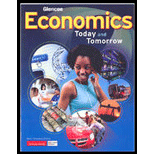
To ascertain the significance of money, medium of exchange, barter, unit of accounting, store of value, commodity money, representative money, fiat money, legal tender.
Explanation of Solution
Money is defined in matters of the three functions or services it provides. Money acts as a trading medium, as a value of store, and as an account unit. Interchange process. The vital characteristic of money is to promote transactions for exchanging.
Act as a medium of exchange;, Is a method or device used to promote the selling, purchase or exchange of products between parties. It facilitates the system of economy to operate fruitfully.
Bartering is the mechanism between two parties of exchanging services or goods, everybody profits when people barter, since they receive goods or services they need or want. There is also a benefit to bartering since even people without money can get everything they need. It had a great advantage at the time when currency was not introduced.
Unit of accounting, money facilitates as a unit of value or a measures of common value. It helps to make market exchange prices. For example money works as a common denomination such as ‘Price’ to express value of all goods and services.
Store of value; Money is a kind of commodity within a capitalist economy that can be used to buy goods and services. The crucial aspects of money is that it acts as a liquidity fund, which means can not only sell it but also save it for future use.
Commodity money; Commodities are considered a strong hedge against inflation as their prices continue to increase during high inflation cycles.
Representative money, a symbolic thing like instruments such as credit cards and checks. Before 1971 the world's currencies were representative, backed by gold
Fiat money, like commodity-based currency such as copper, gold and silver, its value quality is the important elements of fiat money. In the 20th century, the use of fiat cash became widespread as governments and banks stepped in to shield their economies from regular business cycle breakdowns.
Legal tendering; one effect of the law on tendering is that it enables debts and obligations to be dismissed in a cheaper form of "dollars" than gold and silver coins. In particular, to settle "dollar" loans, it uses circulating notes and deposits of the Federal Reserve.
Introduction: In economics, money is known as an asset that acts as accepted means of trade, i.e. it has the advantages of using directly to buy certain goods for sale within the economy.
Chapter 14 Solutions
Economics Today and Tomorrow, Student Edition
Additional Business Textbook Solutions
Horngren's Accounting (12th Edition)
Intermediate Accounting (2nd Edition)
Horngren's Cost Accounting: A Managerial Emphasis (16th Edition)
Financial Accounting: Tools for Business Decision Making, 8th Edition
Operations Management
Engineering Economy (17th Edition)
- not use ai pleasearrow_forwardUse the following table to work Problems 5 to 9. Minnie's Mineral Springs, a single-price monopoly, faces the market demand schedule: Price Quantity demanded (dollars per bottle) 10 8 (bottles per hour) 0 1 6 2 4 3 2 4 0 5 5. a. Calculate Minnie's total revenue schedule. b. Calculate its marginal revenue schedule. 6. a. Draw a graph of the market demand curve and Minnie's marginal revenue curve. b. Why is Minnie's marginal revenue less than the price? 7. a. At what price is Minnie's total revenue maxi- mized? b. Over what range of prices is the demand for water from Minnie's Mineral Springs elastic? 8. Why will Minnie not produce a quantity at which the market demand for water is inelastic?arrow_forwardDon't give AI generated solution otherwise I will give you downward Give correct answer with explanationarrow_forward

 Principles of Economics (12th Edition)EconomicsISBN:9780134078779Author:Karl E. Case, Ray C. Fair, Sharon E. OsterPublisher:PEARSON
Principles of Economics (12th Edition)EconomicsISBN:9780134078779Author:Karl E. Case, Ray C. Fair, Sharon E. OsterPublisher:PEARSON Engineering Economy (17th Edition)EconomicsISBN:9780134870069Author:William G. Sullivan, Elin M. Wicks, C. Patrick KoellingPublisher:PEARSON
Engineering Economy (17th Edition)EconomicsISBN:9780134870069Author:William G. Sullivan, Elin M. Wicks, C. Patrick KoellingPublisher:PEARSON Principles of Economics (MindTap Course List)EconomicsISBN:9781305585126Author:N. Gregory MankiwPublisher:Cengage Learning
Principles of Economics (MindTap Course List)EconomicsISBN:9781305585126Author:N. Gregory MankiwPublisher:Cengage Learning Managerial Economics: A Problem Solving ApproachEconomicsISBN:9781337106665Author:Luke M. Froeb, Brian T. McCann, Michael R. Ward, Mike ShorPublisher:Cengage Learning
Managerial Economics: A Problem Solving ApproachEconomicsISBN:9781337106665Author:Luke M. Froeb, Brian T. McCann, Michael R. Ward, Mike ShorPublisher:Cengage Learning Managerial Economics & Business Strategy (Mcgraw-...EconomicsISBN:9781259290619Author:Michael Baye, Jeff PrincePublisher:McGraw-Hill Education
Managerial Economics & Business Strategy (Mcgraw-...EconomicsISBN:9781259290619Author:Michael Baye, Jeff PrincePublisher:McGraw-Hill Education





